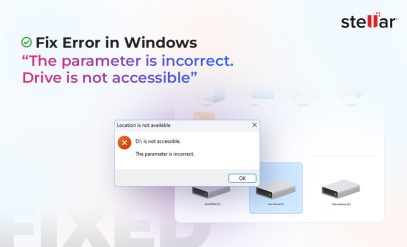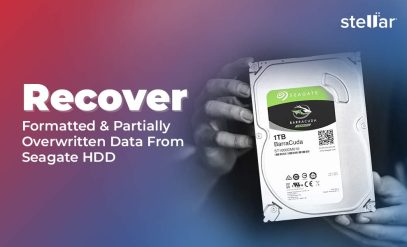Incremental Vs Differential Backup: Different Types of Backup [2025]
Summary: Data is king in our world. From personal photos to business-critical files & applications, losing a bit of information can be devastating. So, backup came in as a safety net here. It ensures you can recover your data in case of a system failure. Individuals can use several backup strategies. However, two popular choices are incremental vs differential backup. Here, we will explore these methods. We will be explaining their mechanism & their key differences.
Why do Regular Backups Matter?
It’s not a good thing to lose your work documents, or records due to a computer crash. Regular backups create copies of your data at specific intervals. It allows you to restore it to a previous state if disaster strikes. Hence, keeping your personal & professional life on track.
But with ever-growing data volumes, creating full backups every time can be time-consuming. So, to address this issue, we use incremental & differential backups. They are more efficient alternatives.
What is Incremental Backup?
This backup strategy focuses on capturing only the data that has changed since the last backup. You can think of it as keeping a daily log of edits made to a document. Each incremental backup is relatively small & quick to perform. Thus, making it ideal for frequently changing data sets.
This strategy has two types. Let’s see the differential incremental backup vs cumulative incremental backup. While both capture changes since the last full backup, differential ones are single files for each change since the full one.
Cumulative incremental backups are less common, & create a chain of backups. It merges changes into a single file over time. Both offer faster restores than traditional incremental backups, but cumulative backups can be more complex & less widely supported by software.
What is Differential Backup?
A differential backup strategy captures all the changes that have occurred since the last full backup. In simpler terms, you create a new version of your entire document. It incorporates all the edits made since the last full copy.
If you want to perform on your computer, check the Windows backup incremental vs differential. Windows backup offers both incremental & differential options. If you choose differential backups, it will capture all changes since the last full backup in a single file. Hence, it enables faster restores but uses more storage space than incremental backups.
How do these Backup Strategies Work?
Both incremental backup and differential backup strategies rely on an initial full backup to create a baseline copy of all your data. Here’s a breakdown of how each method works, step by step:
1. Steps to Incremental Backups
Analyze your data to identify files that have changed since the last backup. It might involve comparing timestamps or file checksums.
Only copies those modified files. It keeps the backup size small & the process fast.
Essentially acts like a log of changes since the previous backup. Imagine you’re keeping a daily log noting which files you edited & what changes you made.
2. Steps to Differential Backups:
Similar to incremental backups, the process begins with a complete copy of all your data.
Each differential backup identifies & copies all files that have been added or modified since the last full backup, not just the most recent changes.
Think of it like creating a new version of your entire document that incorporates all the edits made since the last full copy.
Key Differences: Incremental vs. Differential Backup
Keeping your data safe is crucial in today’s digital world. You can use either incremental or differential backups. They are more efficient alternatives that focus on capturing only the changes in your data. However, these two methods have some key differences. Let’s understand them so you can choose the right strategy:
Here are the features of Incremental Backup strategies, including:
1. More Speed
They’re lightning-fast because they only focus on the data that has been modified since the last backup. It makes them ideal for frequently changing datasets, like business documents or personal photo collections that are constantly being edited.
Since only the changed data is copied, incremental backups are significantly faster to perform compared to full backups. It translates to less time spent waiting for your backup to complete, freeing you up to get on with other tasks.
2. Space Savers.
If you only added new documents every day, you’d need less space compared to constantly refilling everything. Incremental backups follow the same principle. Each backup focuses on the new or modified data. Hence, keeping the overall storage footprint smaller. It is a major advantage, especially if you have limited storage capacity.
3. Slower Restoration
While incremental backups are speedy & space-saving, restoring data from them can be a bit slower. To recover a specific file, you’ll need to apply all the incremental backups since the initial full backup. Imagine recreating your document by combining all your daily edit logs. It can be time-consuming for extensive data changes.
Additional Reading: Database Backup and Recovery from Catastrophic Failures
Here are the features of Differential Backup strategies, including:
4. Balance Between Speed & Space
Provides a middle ground between speed, space utilization, & return time. Instead of viewing changes since the last backup, all changes since the last full backup are captured.
Think of it as if you were updating your entire document including all changes since the last one. While this takes longer than an incremental backup (because it must reflect all changes), it is faster than a full backup.
5. Need More Space
Although differential backups are faster than full backups, they use more storage space compared to incremental backups. Over time, the size of differential backups can increase significantly, especially if you don’t do full backups very often.
6. Fast Restoration
Here are the main advantages of differential backups: restoring data is faster than incremental backups. All you need to get everything back is the initial full backup & latest differential backup. It seems you only need the whole document & the most recent “edits log” to recreate your work.
What is the Difference Between Incremental and Differential in Cobian Backup?
Cobian backup, like many backup programs, allows you to choose between incremental & differential backups. Here is a quick comparison of Cobian backup incremental vs differential:
Incremental Backup: Cobian will only copy files that have changed since the last backup. It speeds up & reduces storage usage, which is great for manipulating data repeatedly. However, you need to use all incremental backups starting from full to restore the data.
Difference Backup: Cobian will capture all changes in a single file after the last full backup. It provides faster recovery compared to incremental backups because you only need a full original backup.
Additional Reading: How To Backup WD My Cloud To An External Hard Drive
Other Backup Strategies: Full vs Incremental vs Differential Backup
Keeping your data safe is important, but there are options to consider. Now, we are exploring three main options: full vs incremental vs differential backup:
- Full Backup: The easiest option. It makes a copy of your entire data set, all files & folders, at a certain point in time. While secure & complete, full backups can be slow & require as much storage.
- Incremental Backup: Ideal for constantly changing data. They are only for files that have changed since the last backup. This makes them faster & uses less storage, but restoring data requires all incremental backups nonetheless, which can be time-consuming.
- Differential Backups: Balance, all changes are captured since the last complete backup, not just the most recent. It makes restores faster compared to incremental backups, but the size of differential backups can increase as changes accumulate.
Additional Reading: How to Backup Data without Booting Windows 10
Summary of Backup Types
Here is a quick summary of backup types incremental vs differential, including:
| Feature | Incremental Backup | Differential Backup |
|---|---|---|
| Speed | Fastest | Faster than Full, Slower than Incremental |
| Storage Space | Least Space Required | More Space than Incremental, Less Than Full |
| Restore Time | Slowest | Faster than Incremental |
| Ideal for | Frequently changing data | Balance of speed & restore time |
| Example | A daily log of document edits. | The new version of the document with all edits since the last full backup. |
Choosing the Right Backup Strategy: Incremental vs. Differential
The best way to meet your backup needs depends on several factors:
- Frequency of data changes: If your data changes frequently, incremental backups can be ideal due to faster backup speed & minimal storage consumption
- Data Restore Requirements: When rapid data recovery is paramount, differential backup offers advantages with faster recovery times.
- Storage capacity: When storage space is limited, incremental backups can be a good option due to their small size.
Conclusion
Protecting your data is paramount. Regular backups ensure that critical information can be recovered in the event of a disaster. While full backups provide total security, they can be time-consuming & storage-intensive. This is where incremental & differential backups come into play.
Understanding the key differences between these options is important to choosing the right storage option for your needs. Also, have any questions or backup strategies you’d like to share? Talk about it below!
FAQs
1. What is a backup?
A backup is a copy of your data stored in a separate location. It ensures you can recover your files, documents, photos, & other important information if the original data is lost due to a system crash, hardware failure, accidental deletion, or even cyberattacks.
2. How often should I back up my data?
The frequency depends on how critical your data is & how often it changes.
Daily or even more frequently using incremental backups.
Weekly or monthly using differential or full backups.
Periodic full backups might suffice.
3. Where should I store my backups?
There are several options, each with its advantages:
- Local storage: Provides direct access but is vulnerable to physical damage like fire or theft.
- Cloud storage: Offers remote access, security, & redundancy but may incur subscription fees & depend on internet connectivity.
- Network-attached storage: A centralized storage solution for multiple devices but requires additional hardware investment.
Additional Reading: Exploring Benefits of Different Data Storage Devices







